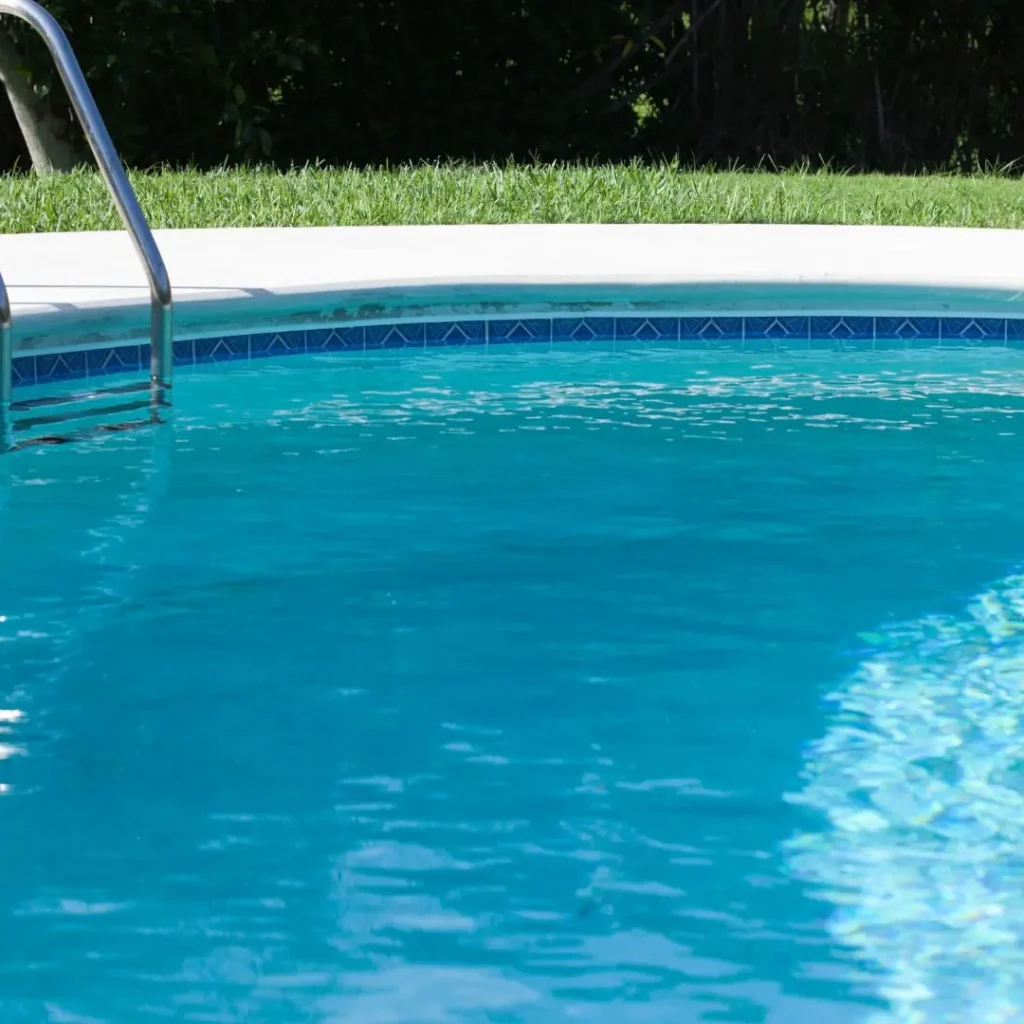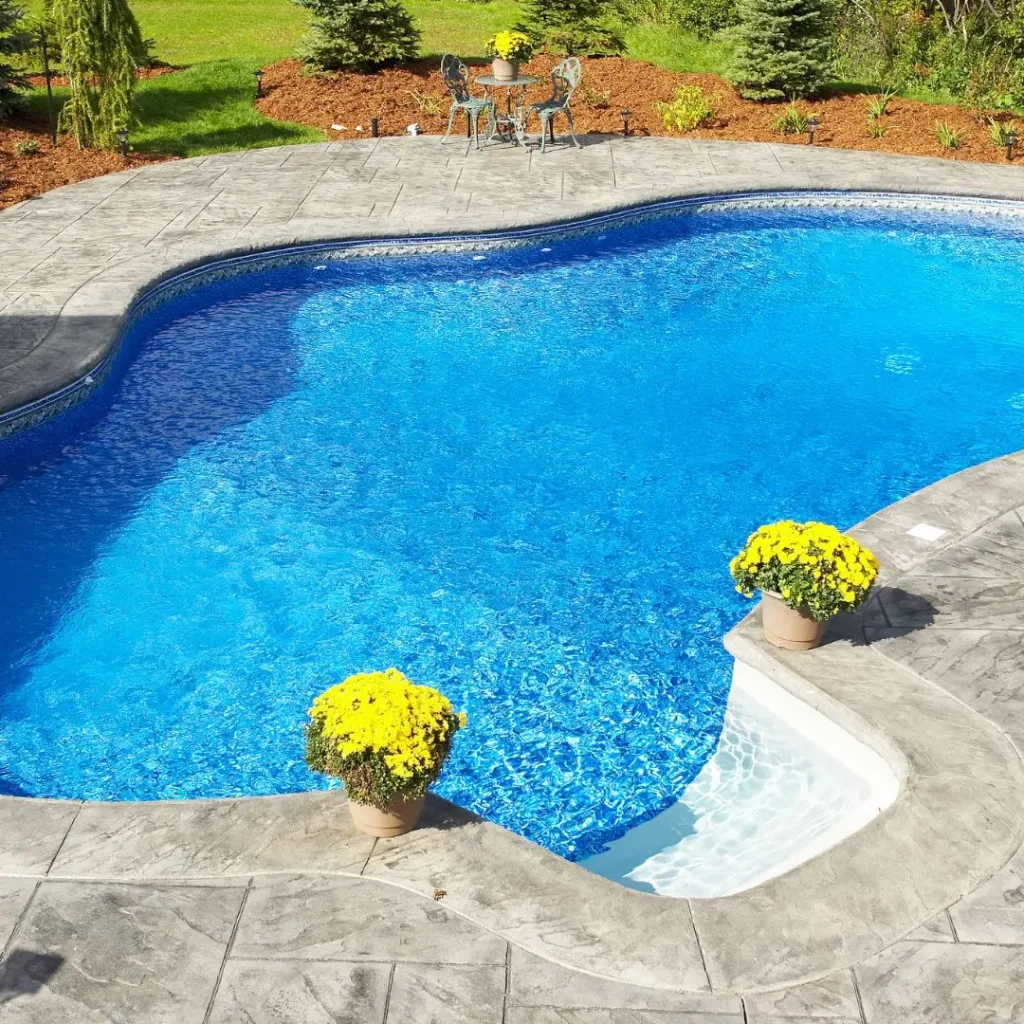Cantilever Coping: What Is It, and Is It the Right Choice for Your Pool?
If you’re planning to remodel your pool area or install a new one, there are a lot of decisions to make. One of them has to do with your pool coping. Is cantilever coping the right choice?
Cantilever coping is one of the most popular choices both for its look and price.
So let’s have a quick look at what cantilever (or cantilevered) pool coping is and why you should consider it.
Why trust us? A&X Masonry was founded in 2009 and since then we’ve worked on countless pools. Our master masons have decades of experience working with poured concrete, decorative concrete, patio pavers, natural stone, and more.
What is Cantilever Pool Coping?

Cantilever pool coping refers to a style of pool edging that extends slightly over the edge of the pool. It is cantilevered, which means it extends several inches over your pool. Its job is to create a sort of lip or overhang along the pool’s edge.
Poured concrete is commonly used to create a cantilevered edge. In most cases, the contractor will set up special forms around the edge of your inground concrete, vinyl, or fiberglass pool. Many use forms that will leave a bullnose or other decorative edge instead of just square concrete.
Thanks to cantilevered concrete, you can have this option instead of just using pavers or bricks. Let’s look at some of the pros and cons of cantilevered coping around swimming pools.
Cost of Cantilever Pool Coping
When considering the cost of cantilever pool coping, several factors come into play, including the type of materials used, the complexity of the installation, and the overall size of your pool.
On average, cantilevered concrete coping ranges from $6 to $20 per linear foot. This price point may vary based on additional decorative elements or custom designs. It can also depend on whether the coping is part of a larger pool installation package or is a standalone installation.

Installation Process of Cantilevered Pool Coping
The installation process of cantilevered pool coping involves precise steps to achieve a seamless finish. Here are the basic steps your contractor will take to installed cast-in-place concrete cantilever coping.
- The edge of the pool and pool deck are prepared for the cantilevered concrete coping.
- Forms are set up around the edge of the pool.
- Control and expansion joints are strategically placed to prevent cracking, improve the durability of the coping and protect your pool’s structure. Note: Some expansion joint materials are placed before pouring. And some control joints are troweled or cut into the concrete after pouring.
- Concrete is poured along the pool’s edge.
- As the concrete cures, the surface is finished. In come cases this could include stamping a design into the concrete to mimic natural stone.
Advantages of cantilevered coping
Pro 1 – Low Maintenance
In general, very little maintenance is required when it comes to concrete. Just sweep it clean, and from time to time spray it off with a hose or pressure washer.
Pro 2 – Cost
Concrete is a relatively inexpensive material. Most of what you will pay for will be the labor of building the forms and pouring the cantilevered concrete.
But in comparison with using pavers, tiles, or brick for pool coping options, cantilevered concrete coping is usually more budget-friendly. But that doesn’t mean it looks cheap. Well-installed cantilevered coping can give pools that custom, high-end look.
Pro 3 – Versatility
Concrete forms can be made to fit any pool shape and design. So it doesn’t matter how many angles, curves, or levels your swimming pool area has, cantilevered concrete can be made to fit.
You can also choose from a variety of shapes and surface finishes. Concrete coping can even be stamped and tinted to look like a natural stone finish.
Pro 4 – Durability
When done correctly, reinforced cantilevered concrete coping is one of the most durable coping methods you can install around your pool.

Disadvantages of cantilever coping
Con 1 – Improper installation
If pavers are improperly installed, they can be easier to repair or replace. However, poured concrete’s durability also makes it more challenging to repair if something does go wrong.
If it’s not properly reinforced and no control joints are added, the concrete coping can crack with time and it can even cause damage to the walls of your swimming pool.
That’s why it’s best to hire pool coping experts, like AX Masonry. If you’re in the Garland, Texas area, give us a call today for a FREE consultation!
Con 2 – Rough Surface
While the overhand of the cantilevered coping gives you something to grab onto when getting out of the pool, more of it will come in contact with your body as you pull yourself over the edge.
And since the concrete coping has a rough finish (so you don’t slip on it), it can be a little hard on your skin. That’s another reason why it’s best just to use the pool ladder!
How Far Does Cantilevered Coping Extend from the Pool?
- Adding a more premium look to the edge of the pool
- Reducing water splash by redirecting water back into the pool instead of letting it spill over onto the deck.
- By reducing water splash out it protects the pool deck from staining and erosion.

Is Cantilevered Pool Coping the Best Choice for Your Inground Pool?
If you’re looking for a custom look that will be safe, durable, and help provide stable conditions to your pool deck, cantilever concrete pool coping is a fantastic choice! When done properly, it will last a long time.
Whether inground concrete, vinyl, or fiberglass pools, talk to your contractor about what decorative options they offer. Try decorative edging, stamped designs, and even added colors that can make the concrete pool coping job look like more expensive natural stone.
You deserve to get your pool coping and patio hardscapes done right the first time! If you’re in the Garland or Dallas, Texas area, call the pool coping experts at AX Masonry by phone (972) 217-0296. Get your FREE consultation today!
Cantilever Pool Coping FAQs
Does pool coping have to overhang?
Pool coping doesn’t have to overhang. However, most pool coping typically features an overhang, even if it’s a small one. This overhang serves practical purposes, such as providing a grip for exiting the pool and directing water runoff, while also contributing to the overall aesthetic appeal.
Why go with cantilever coping?
Choosing cantilever coping for your pool patio offers several advantages, including a sleek, modern look. The concrete edging integrates nicely with a concrete patio. Additionally, cantilever coping provides durable and low-maintenance options, so it’s an ideal choice for pool owners who want both functionality and style.
What is pool coping anyway?
Pool coping refers to the material installed around the edge of a pool, serving as a transition between the pool and the surrounding decking. It not only adds to the pool’s aesthetic but also provides essential safety features. Cantilevered coping is a popular choice due to its seamless design and effective splash protection.
